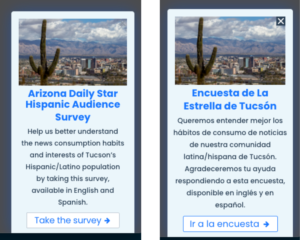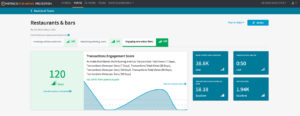How Metrics & Surveys Can Help You Better Understand & Serve Your Community
A recent cohort hosted by Metrics for News – Reaching New Audiences – brought together publishers from around the world to look at data-driven strategies to reach new audiences. Below is the result of a successful experiment using reader and community surveys at The Arizona Daily Star, which is working to better understand its Spanish-reading audience and Tucson’s wider Hispanic community.
Executive Summary
The Arizona Daily Star’s mission is to inform and reflect its diverse Tucson community with deep, impactful journalism. For many years, the industry’s emphasis on the print product led The Star to write with a focus on what our subscribers would be interested in. However, its subscriber base isn’t reflective of Tucson’s community, which has a growing Hispanic population of more than 40 percent. To better understand the interests of the local Hispanic community and their news consumption habits, The Star launched a community survey. The survey responses will hopefully inform all news beats, as well as product development.
Background
Tucson’s Hispanic population is more than 40 percent of the community. While The Star doesn’t have demographic data on its subscribers as far as race is concerned, looking at ZIP code data for subscribers, they knew they were not reaching areas with high Hispanic populations. “The richness of our community comes from all of the people and cultures it is made up of, and what The Star is seeking to do is to ensure that our coverage gives a voice to these communities; is celebrating the successes of these communities; and that we are writing for these communities, rather than simply writing about them,” said Alexis Huicochea, Business, Metro & Features Team Leader, at The Arizona Daily Star.
Before launching the community survey, The Star also began tracking Spanish-speaking audiences in their analytics tools, including API’s Metrics for News. Metrics for News is a content strategy and news analytics tool that can help publishers learn what, why and how audiences engage with their journalism. While Metrics for News displays a lot of information on the audiences who engage with our stories, including age and gender demographics and the platforms being used to find our coverage, it does not provide information on ethnicity, which is key in helping to identify whether The Star is reaching its intended Latino audience, said Huicochea. “What we could track with Metrics for News, however, was users who had their browsers set to read Tucson.com in Spanish. While we understand that the data gleaned from that audience doesn’t provide the full picture as many Latino people aren’t Spanish-readers and some Spanish-readers aren’t Latino,” she adds. Tracking this kind of audience data can inform which of The Star’s English-language stories are performing well with Spanish-language readers. That helps inform decision making on stories that should be translated for use in La Estrella, the Star’s Spanish-language publication, which has a growing audience—from nearly 149,000 users in 2019 to nearly 442,000 users in 2021.
The experiment
The Star conducted a community survey (using SurveyMonkey) in both English and Spanish in an effort to “better understand the interests of the local Hispanic community as well as news consumption habits to ensure that we are not only delivering content that our community wants but also that we are delivering it in the right ways,” said Huicochea.
Audience engagement tip: To reach people in your community who might not already be readers, but are part of a target audience you want to engage, partner with organizations that serve that part of your community and/or are run by those community members. Consider using this as a first step to develop more ongoing relationships with those organizations for ongoing events, discussions, and partnerships.
The online survey was open for 10 days. The survey link was shared in print, with an explanation of The Star’s intentions to make its coverage reflective of the community, as well as through social media postings, newsletters and pop-up ads (see images below for samples) on Tucson.com and on Tucson.com/LaEstrella. It was distributed in both English and Spanish and local organizations serving the Hispanic community were asked to share the link, said Huicochea.

Examples of how The AZ Daily Star promoted its survey in English and Spanish on its websites and social media.

The outcome: 232 people took the survey in English and 93 took it in Spanish for a total of 325 responses. In addition, nearly 132,000 people saw the pop-up ad in English on Tucson.com and that 255 clicked through. About 3,875 people saw the pop-up in Spanish and 16 clicked through. Despite having a low click-through rate, The Star knows the survey was aimed at a particular demographic and getting its mission statement out to its community is a step in the right direction in showing its commitment to do better.
Audience engagement tip: Surveys are an excellent, first step toward engaging your audiences – and broader community – and learning more about their reading habits and interests. It’s also a way to try and reach non-readers by partnering with local organizations who can help reach folks who might not be a core part of your current audience. This helps to put you in front of potentially new readers as well as build relationships with a diverse group of organizations. Those relationships could be the start of live, in-person events, news tips, and sources. Also consider promoting the survey on social media to non-readers, using paid promotions on Facebook as well as posting to local Reddit Subreddits and public Facebook groups.
What they learned
In terms of news consumption habits, both surveys showed about a quarter of respondents read their news in English and Spanish. For those who took the survey in English, 67 percent got their news by going directly to Tucson.com or searching for it on Google. However, for those who took the survey in Spanish, 71 percent of respondents say they rely on Facebook for their news. Those survey findings align with what The Star is seeing in Metrics for News, which The Star uses to track a variety of ways in which their audiences engage with their stories: Roughly 80 percent of their social media traffic comes from Facebook; and, more than 50 percent of The Star‘s Spanish-language audience, as measured in Metrics for News, comes via search while 20 percent is coming directly to Tucson.com.

Above is a a topic-level dashboard in Metrics for News that shows how content about bars and restaurants is earning above-average engagement (in green) with all key audience segments (general online audience, existing users and new subscribers) of Daily Star readers.
In terms of topics of interest, The Star found the highest-rated topics were news you can use, such as things to do, new restaurants to visit, how to stay healthy, information on personal finance, information on how to find a school for their children, scholarship information, and local politics (see image, left). “There was also a fair amount of interest in getting to know our community members whether that was through profiles of local leaders, or success stories about Latino youth and Latinos in STEM. We understand that our Hispanic community is diverse and that the survey results are not all encompassing, but it certainly provides some insight into the type of coverage that could be of interest,” said Huicochea. “Looking at the Star’s metrics (see chart below), our business content, which features information on new businesses, restaurants, housing and finance, performs well in English, but also when it is shared on La Estrella in Spanish. The content produced by our features team, including entertainment and food news, also performs well in both English and Spanish.”
Next steps
The Star plans to analyze the data and share the information with the entire newsroom as a way to not only spark story ideas and emphasize better diversity in sourcing, but also to develop newsletters around certain topics. One such newsletter will be in Spanish, focusing on the top news of the week, things to do, and a community resource. Metrics for News can be utilized to identify the top-performing stories and topics to be included in the newsletter. “We are also considering how to deliver the newsletter, potentially utilizing SMS or a social media platform rather than email, since the survey showed more reliance on social media for news consumption in the Spanish survey than it did in the English survey,” said Huicochea. The success of the newsletter, and its impact on story performance through referrals and direct audience, can also be measured through Metrics for News, along with further insight on the audiences engaging with the stories. The Star can also monitor La Estrella’s Metrics for News data to identify original Spanish-language content—both topic and story type—that is performing well and can be translated for its English-reading audience.
“In sharing the overall findings from the surveys, we are working to instill in the newsroom that the effort to serve our Latino community isn’t limited to our Spanish-language publication, or to a beat reporter assigned to amplify the diverse voices of our community,” said Huicochea, “but something that can be done on all beats.”
Caption (MFN graphic): This image is of a topic-level dashboard in Metrics for News that shows how content about bars and restaurants is earning above-average engagement (in green) with all key audience segments (general online audience, existing users and new subscribers) of Daily Star readers.
READ MORE FROM:Case studies & Resources
